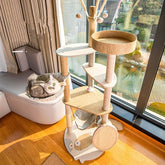Understanding Your Cat's Affection: Why They Love to Lay on Your Chest
Table of Contents
- Key Highlights:
- Introduction
- The Comfort of Closeness
- Understanding Cat Behavior
- Common Signs of Contentment
- Common Misconceptions About Cats Laying on Your Chest
- Veterinary Insights
- When to Seek Veterinary Help
- Tips for Fostering a Strong Bond
- FAQ
- Conclusion
Key Highlights:
- Cats often lay on their owners' chests for warmth, security, and bonding, reflecting their affectionate nature.
- Common signs of contentment include purring, kneading, and relaxed body posture, indicating they feel safe and comfortable.
- While this behavior is typically benign, any sudden changes or signs of distress may warrant a veterinary consultation.
Introduction
The bond between humans and their feline companions is often enriched by simple yet profound moments of affection. One of the most cherished behaviors among cat owners is when their furry friends choose to settle comfortably on their chests. This endearing act, often accompanied by a gentle purr, is not merely a random occurrence; it is a complex interplay of instincts, emotions, and needs. Exploring the reasons behind this behavior can deepen our understanding of cats and enhance the bonds we share with them.
The Comfort of Closeness
When a cat jumps onto your chest, it is often a sign of affection. This physical closeness allows them to feel your heartbeat, which can be comforting. The warmth of a human body is particularly inviting for cats, who are drawn to cozy spots. Your chest provides a snug resting place that caters to their instinctual need for warmth and safety.
The Science of Purring
Purring is one of the most recognizable sounds associated with cats and serves as a significant indicator of their emotional state. When a cat purrs while resting on your chest, it typically signifies contentment. This soothing sound is produced by rapid contractions of the muscles within the cat's larynx, allowing them to take in air while purring both in and out. The vibration frequency of a cat's purr (between 25 and 150 Hertz) has been associated with promoting healing processes in bones and tissues. This phenomenon suggests that purring may not only indicate happiness but could also be a self-soothing mechanism, providing comfort to the cat.
Understanding Cat Behavior
Cats are known for their unique and sometimes puzzling behaviors, and laying on their owner's chest is no exception. Understanding the motivations behind this action can help pet owners foster a deeper connection with their pets.
Seeking Warmth
Cats are natural heat-seekers. In the wild, they gravitate toward warm spots to conserve energy and maintain body temperature. Your chest, being warm and soft, offers an ideal resting place. This behavior is particularly common in colder months when cats are more likely to snuggle for warmth.
Bonding and Affection
Laying on your chest is also a behavior that signifies affection. Cats are social creatures, and they often seek closeness as a way to bond with their humans. This behavior reflects a level of trust and comfort, indicating that your cat feels secure in your presence.
Marking Territory
Cats possess scent glands on their paws and face, and by rubbing against you or choosing to lay on your chest, they are marking you as part of their territory. This behavior is a form of communication, signifying that you are a valued member of their social group.
Security and Observation
From a higher vantage point, cats can observe their surroundings, which contributes to their feeling of security. Laying on your chest allows them to feel protected while remaining aware of their environment. This instinctual behavior stems from their wild ancestors, who needed to be alert to potential threats.
Common Signs of Contentment
When a cat chooses to lay on your chest, there are several signs to look for that indicate they are comfortable and happy. These behaviors can help you assess your cat's emotional state:
- Purring: A clear sign of contentment, purring is often accompanied by relaxed body language.
- Kneading: Cats may knead with their paws, a behavior rooted in kittenhood when they kneaded their mother’s belly to stimulate milk flow.
- Relaxed Body Language: A cat that is comfortable will often have a relaxed posture, with their body sinking into you rather than tensing up.
Common Misconceptions About Cats Laying on Your Chest
Despite the affectionate nature of this behavior, some misconceptions persist among cat owners. One prevalent myth is that a cat laying on your chest is a sign of dominance. In reality, this behavior is more about seeking comfort and bonding than asserting power. Understanding the nuances of feline behavior can help create a more harmonious relationship.
Veterinary Insights
To further understand this behavior, insights from veterinary professionals can provide clarity on when this behavior is healthy and when it may indicate an underlying issue.
Why Does My Cat Always Lay on My Chest?
Veterinarians affirm that many cats enjoy this behavior as a way to feel close and secure. It is often driven by a desire for warmth and affection, rather than a need to dominate.
Is It Safe for My Cat to Lay on My Chest?
As long as your cat appears comfortable and does not exhibit signs of distress, it is typically safe for them to lay on your chest. However, if a cat shows signs of discomfort, it is advisable to consult a veterinarian.
Encouraging the Behavior
Creating a warm and inviting space can encourage your cat to seek out your chest for resting. Providing cozy blankets or cushions and spending quality time with your cat fosters this bond.
Managing Excessive Laying
If your cat lays on your chest too often and it becomes uncomfortable, gently guiding them to a nearby bed or blanket can help. Respecting your personal space while still offering affection is key to maintaining a positive relationship.
Signs of Potential Health Issues
In some cases, excessive laying on your chest could indicate health issues, especially if accompanied by behavioral changes. If your cat shows signs of distress or discomfort, a visit to the veterinarian is warranted.
When to Seek Veterinary Help
While many cats enjoy laying on their owners' chests without issue, there are scenarios where this behavior may warrant attention:
- Signs of Distress: If your cat appears uncomfortable or restless while laying on your chest, it may be time to consult a veterinarian.
- Sudden Behavioral Changes: Changes in your cat's demeanor, such as increased aggression or withdrawal, should be addressed immediately.
- Respiratory Issues: Difficulty breathing or other respiratory symptoms require prompt veterinary evaluation.
Tips for Fostering a Strong Bond
Building a strong relationship with your feline friend involves understanding their needs and creating a nurturing environment. Here are some tips to enhance your relationship with your cat:
- Positive Reinforcement: Reward your cat with treats or affection when they choose to lay on you, reinforcing this behavior as positive.
- Quality Time Together: Spending time with your cat, whether through play or simply being present, fosters a sense of security and connection.
- Create a Cozy Environment: Providing warm and comfortable resting spots will encourage your cat to seek closeness with you.
FAQ
Why does my cat lay on my chest?
Cats often lay on their owners' chests to feel close, secure, and warm. This behavior is a natural expression of affection.
Is it safe for my cat to lay on my chest?
Yes, it is generally safe as long as your cat is comfortable. Monitor for any signs of distress.
How can I encourage my cat to lay on my chest?
Create a cozy environment and spend quality time with your cat to encourage this affectionate behavior.
What should I do if my cat lays on my chest too often?
If it becomes uncomfortable, gently guide your cat to a nearby cozy spot to rest while maintaining affection.
Could my cat laying on my chest indicate a health issue?
If your cat exhibits signs of distress or changes in behavior, consult a veterinarian for an evaluation.
How can I tell if my cat enjoys laying on my chest?
Signs of enjoyment include purring, kneading, and relaxed body language, indicating your cat feels safe and content.
Conclusion
Understanding why cats choose to lay on their owners' chests can significantly enrich the relationship between humans and their feline companions. By recognizing the underlying motivations—such as seeking warmth, bonding, and security—pet owners can nurture a deeper connection with their cats. Observing their behaviors and responding appropriately can lead to a harmonious and affectionate companionship that both parties cherish.





